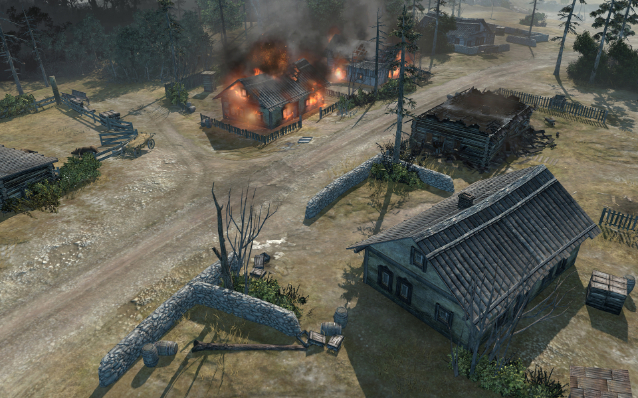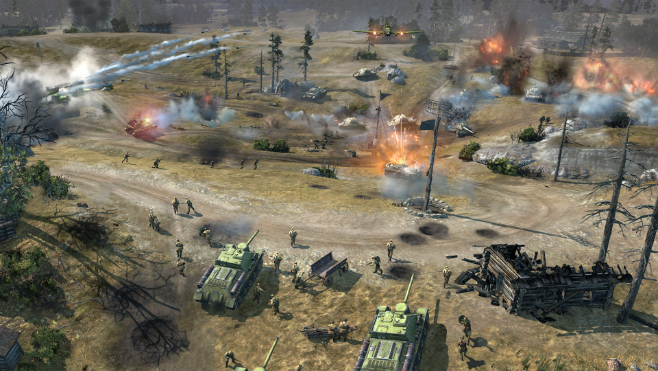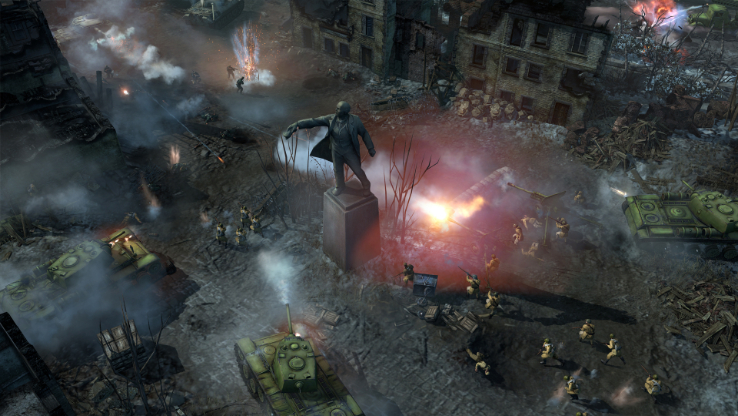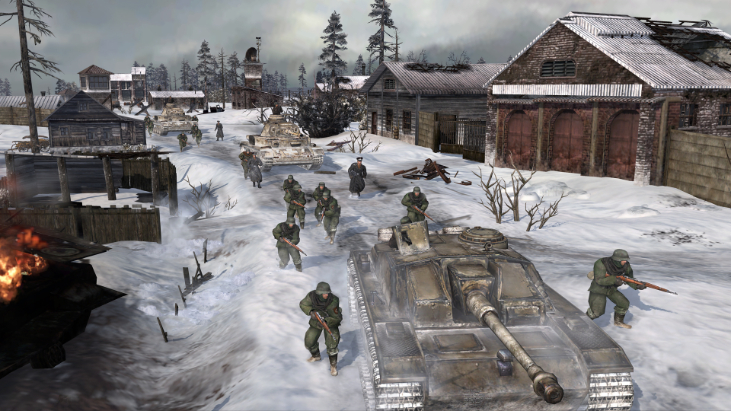Company of Heroes 2 is the sequel to arguably the best and highest rated RTS game for PC, developed by Relic Entertainment and published by Sega, after changing hands from the unfortunate THQ. Set on the Eastern Front of Europe during World War 2 it features battles predominantly between the Germans and Soviets, though some other Eastern European units do occasionally appear.
 The singleplayer follows the exploits of Lieutenant Abramovich, recalling events of the war to a former commanding officer. As it involves the Soviets it sheds a light on the dark history that surrounds their tactics and how they handled (or mishandled) their troops. It never makes light of the way many of the soldiers or civilians were treated but it also never establishes any real connection between the player and the characters involved. It may be partly due to the fact that there is no history to the characters you see put in these situations, just characters that happen to be there.
The singleplayer follows the exploits of Lieutenant Abramovich, recalling events of the war to a former commanding officer. As it involves the Soviets it sheds a light on the dark history that surrounds their tactics and how they handled (or mishandled) their troops. It never makes light of the way many of the soldiers or civilians were treated but it also never establishes any real connection between the player and the characters involved. It may be partly due to the fact that there is no history to the characters you see put in these situations, just characters that happen to be there.
It probably doesn’t help if you already know about the Eastern Front going into the game. Things that would seem horrific and sudden are expected throughout the entire story when you know what happened. The characters lack any definition other than soldier doing his duty, and the particular characters that do show more than just this one defining quality, soon disappear.
Missions themselves have a fair amount of variations and are normally sectioned up as different objectives are met. There are pretty simple missions, much of which is attacking or defending positions you must capture. Unfortunately the missions that stand head and shoulders above the rest aren’t the most action packed or in particular abundance. A tank hunting mission and stealthy Sniper mission have some of the interesting and intense moments in them, but they are brief in comparison to the attack and defend missions that are the bread and butter of this campaign.
 New features such as True Sight and snow change how the game is played quite radically at times. Fog of war is obviously quite an important part of keeping troops hidden, so the fact that you can now hide units around corners or block vision with high structures with True Sight. This allows you to creep your units them ever closer to your opponent, while still keeping them safe(ish).
New features such as True Sight and snow change how the game is played quite radically at times. Fog of war is obviously quite an important part of keeping troops hidden, so the fact that you can now hide units around corners or block vision with high structures with True Sight. This allows you to creep your units them ever closer to your opponent, while still keeping them safe(ish).
Winter is a harsh season, and the snow it brings carries no allegiance. Only on certain missions and map types will snowy weather take place. When it does, it leaves infantry at a disadvantage, or more accurately, some infantry. The cold will soon slow your troops as they trudge through the snow and after braving the cold for too long without warmth or shelter, they will begin to die. Cover keeps them protected from the cold wind, shelters and engineer built fires will warm them up to an acceptable temperature, staving off the cold that can be so deadly.
Blizzards will reduce movement of infantry and all units’ sight ranges, including the usually cold resistant, long ranged snipers. It can lead to snipers walking into the firing line more easily than usual but Blizzards don’t last too long, thankfully. Fires can’t be built during Blizzards so you’ll have to set them up prior or get infantry to cover, warmth or shelter to reduce the impact as much as possible.
 Theatre of War, the mode that’s halfway between single and multiplayer, represents what the campaign could have been far better. By taking individual battles or events from the Eastern Front and not having to shoehorn them in with any story, has meant that they can focus on interesting battles or objectives. The Solo Challenges are a little daunting at first but are manageable, while the AI battles are more standard battles and Co-op Challenges add the variety from the Solo Challenges to a bigger field.
Theatre of War, the mode that’s halfway between single and multiplayer, represents what the campaign could have been far better. By taking individual battles or events from the Eastern Front and not having to shoehorn them in with any story, has meant that they can focus on interesting battles or objectives. The Solo Challenges are a little daunting at first but are manageable, while the AI battles are more standard battles and Co-op Challenges add the variety from the Solo Challenges to a bigger field.
It’s worth noting that the multiplayer benefits also seep into Theatre of War. The only thing that isn’t customizable is the commander selection, which gives you a set choice of three. As well as that you can do Co-op challenges with an AI partner if you prefer but oddly (or at least in the press version) you can’t match make Co-op Challenges, instead you may take a friend via Steam or an AI ally. This isn’t too great if you have yet to get a friend with the game.
Multiplayer is the other side of the coin in strategy games, some people prefer it, some will stick to singleplayer. If you love multiplayer then you’re in luck, it is the strongest portion of the game, not that the rest of the game is bad by any means. You have your Victory point game mode and annihilation as the only two options, which might disappoint some who like more variety in their game modes but they are solid gametypes. You can adjust how many Victory points you work to and the resources you get to work with but other than that you can only customise the armies and map choices.
 Most maps have both normal and snow based variants, including varied capture points between their parallels. There are also three new capture points that give advantages while under your control. Watchtowers give you a far wider viewing range, and the first aid camp and vehicle repair camp will heal/repair their respective unit types. These, like Victory, Munitions, and Fuel points cannot be built on for further bonuses, making them far easier to capture and more important to defend.
Most maps have both normal and snow based variants, including varied capture points between their parallels. There are also three new capture points that give advantages while under your control. Watchtowers give you a far wider viewing range, and the first aid camp and vehicle repair camp will heal/repair their respective unit types. These, like Victory, Munitions, and Fuel points cannot be built on for further bonuses, making them far easier to capture and more important to defend.
The progression system allows you to steadily unlock improvements for your troops (only three may be equipped at a time), new commanders and vehicle skins. Not the most important of things but the bulletins (improvements) help you mould an army to your playstyle with build time decreases, unit buffs etc but all are tied to very specific units, making it so it only gives small advantages in certain situations. Commanders are always chosen in threes but in game you can chose just the one for that match. Whether you want an infantry focus, access to certain artillery types or specialised vehicles, your commander choice is an important choice that not only depends on playstyle but also what your opponent chooses. If you’ve had a chance at the Beta tests that were run, then you get to carry over all your progression.
Story
If you have any knowledge of the events that passed during World War Two on the Eastern Front, then not much will surprise you or even make you think twice. The lack of exposition for the characters will be what causes you to just not care about them, despite them being reasonably well portrayed and voice acted. It is by no means a terrible story but it just won’t hit home as hard as the stories from the original Company of Heroes and its expansions.
Presentation and Audio
One of the nicest looking strategy games you’ll see but it is grounded with a shade of realism, making it very grey/brown, though the foliage and snow does look very nice as well. If you get the chance to pay full attention to the details during combat you can see some detailed destruction on buildings, infantry crawling away wounded but not dead and various things including bodies, ice and snow exploding. The music is sombre at the right moments and heavier during the war scenes and generally fits the mood and tone of the game; it will go by almost totally unnoticed in some instances though.
Gameplay
The want for a story that follows the path of one man is its biggest flaw, many of the Theatre of War missions (that are also grounded by real events) would have been far better in the main list. While the Singleplayer is a bit of a let-down, Multiplayer is structurally sound. Gameplay is as its predecessor but improved and it has a reward system in place that urges you to continue playing. Because you can rank up via any game mode, those more interested in Singleplayer campaigns and Theatre of War won’t be at any particular disadvantage by arriving late to multiplayer.
Overall
If you liked the original game then you’ll love this, no doubt about it, things have changed enough that the gameplay feels familiar but improved. The biggest new features, True Sight and the snow both have their ups and downs but generally are good features that improve the overall experience. While the singleplayer might be a bit of a disappointment, Theatre of War and the multiplayer more than make up for it. Oh and the inevitable expansions should satisfy as they usually do, though it will be quite a wait.
Comments:
Relic is by far my favourite developer and I love what they make, Company of Heroes is one of my favourite games of all time and I even loved Tales of Valours camapigns, short as they might have been. It does surprise me slightly that they stuck to only two armies and two multiplayer modes, especially when Theatre of War has defence missions that would be perfect for it, or even a Dawn of War 2 Last Stand mode. Regardless of any issues with it, it stands as a great sequel to a brilliant and ground-breaking game.
Disclaimer:All scores given within our reviews are based on the artist’s personal opinion; this should in no way impede your decision to purchase the game.









You must be logged in to post a comment.